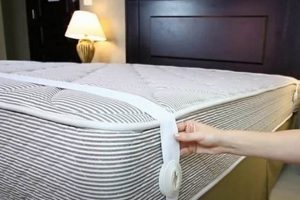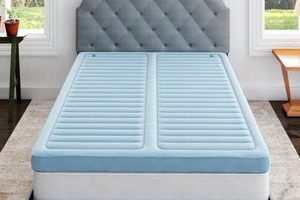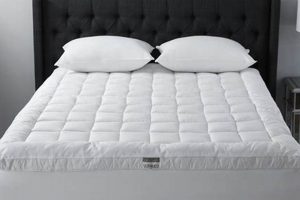A specialized overlay designed to mitigate the risk of decubitus ulcers, or bedsores, often incorporates materials that redistribute weight and reduce sustained pressure on bony prominences. For example, gel-infused memory foam or alternating air cells are frequently employed to provide a more even surface and promote blood circulation in individuals with limited mobility.
The implementation of such support surfaces is a crucial aspect of pressure injury prevention, particularly for patients confined to beds or chairs for extended periods. Their usage is supported by clinical guidelines and has demonstrated effectiveness in reducing the incidence and severity of skin breakdown. Historically, simpler materials were used, but advancements in materials science have led to more sophisticated and effective solutions.
The following sections will delve into the specific types of these therapeutic surfaces available, their respective features and benefits, ideal patient populations for each, and considerations for selection and proper usage within a healthcare or homecare setting. This includes examining material composition, maintenance protocols, and relevant safety standards.
Considerations for Effective Support Surface Utilization
Optimal outcomes when utilizing supportive surfaces for pressure injury prevention rely on informed selection and proper implementation. The following guidelines address key factors in achieving therapeutic benefits.
Tip 1: Material Selection: Evaluate the material composition based on individual patient needs. Gel-infused foam offers pressure redistribution and temperature regulation, while alternating air models are appropriate for higher-risk patients requiring dynamic pressure relief. Prioritize breathable and moisture-wicking fabrics to minimize skin maceration.
Tip 2: Weight Capacity Adherence: Verify the weight capacity of the support surface prior to use. Exceeding the specified limit compromises the pressure redistribution properties and may lead to device failure.
Tip 3: Proper Placement: Ensure correct positioning of the individual on the support surface. Bony prominences, such as the sacrum, heels, and elbows, should be fully supported and not in direct contact with the underlying mattress.
Tip 4: Regular Inspection: Routinely inspect the support surface for signs of wear and tear, including punctures, tears, or deflation. Damaged surfaces are less effective and may pose a safety hazard.
Tip 5: Infection Control Protocols: Implement rigorous infection control practices, including regular cleaning and disinfection according to manufacturer guidelines. This minimizes the risk of cross-contamination.
Tip 6: Consistent Use: Maintain continuous use of the support surface, even during repositioning or transfer activities, to ensure uninterrupted pressure relief. Temporary removal can negate the therapeutic benefits.
Tip 7: Surface Compatibility: Assess the compatibility of the support surface with the existing bed frame and other medical equipment. Ensure proper fit and stability to prevent falls or accidental displacement.
Implementing these considerations optimizes the functionality and longevity of support surfaces, thereby maximizing their impact on pressure injury prevention and improving patient outcomes. Adherence to these guidelines complements comprehensive pressure ulcer prevention strategies.
The subsequent sections will explore specific product categories, comparative analyses, and future trends in supportive surface technology. Understanding these aspects contributes to informed decision-making and improved patient care.
1. Material Composition
The material composition of a pressure sore mattress topper directly determines its ability to redistribute pressure, regulate temperature, and manage moisture, all critical factors in preventing pressure ulcer formation. For instance, viscoelastic memory foam conforms to the body’s contours, increasing contact area and reducing concentrated pressure on bony prominences. Gel infusions within the foam enhance temperature regulation, minimizing skin maceration caused by excessive perspiration. Conversely, low-density foam or materials lacking breathability can exacerbate pressure and moisture buildup, increasing ulcer risk. A clinical example involves a comparison of patients using standard hospital mattresses versus those utilizing gel-infused memory foam toppers; the latter group exhibited a statistically significant reduction in pressure ulcer incidence, underscoring the practical significance of material selection.
Furthermore, the specific properties of materials influence the longevity and maintenance requirements of the mattress topper. Polyurethane-coated fabrics provide fluid resistance and ease of cleaning, crucial for infection control protocols. However, these coatings may compromise breathability if not properly engineered. Alternating air mattress toppers, while offering dynamic pressure relief, rely on the integrity of the air cells and the pump mechanism. Material failure in these components renders the device ineffective, potentially leading to pressure ulcer development. Therefore, a comprehensive understanding of the material’s physical characteristics, durability, and cleaning requirements is essential for appropriate selection and ongoing management.
In summary, material composition is not merely a feature but a fundamental determinant of a pressure sore mattress topper’s efficacy. The interplay between pressure redistribution, temperature regulation, moisture management, and durability, all dictated by the selected materials, directly impacts patient outcomes. Challenges remain in balancing these competing factors and tailoring material choices to individual patient needs and risk profiles. Future research and development efforts should focus on innovative materials that optimize these properties while minimizing environmental impact and cost.
2. Pressure Redistribution
The core function of a pressure sore mattress topper is pressure redistribution. Prolonged, concentrated pressure on bony prominences is a primary etiological factor in the development of pressure ulcers. These toppers aim to mitigate this risk by increasing the surface area over which the body’s weight is distributed, thereby reducing pressure intensity at any single point. The efficacy of a pressure sore mattress topper is directly proportional to its ability to achieve effective pressure redistribution. For example, a topper constructed from high-density memory foam deforms under load, conforming to the body’s shape and dispersing weight across a larger area. In contrast, a simple foam pad, lacking specific pressure redistribution properties, provides minimal benefit. The importance of this function is underscored by the fact that most clinical g
uidelines for pressure ulcer prevention emphasize the use of pressure-redistributing support surfaces as a fundamental intervention.
Practical applications of this principle are evident in various topper designs. Alternating air mattress toppers cyclically inflate and deflate different sections, constantly shifting pressure points and stimulating blood flow. Gel-infused toppers combine the benefits of pressure redistribution with temperature regulation, further enhancing skin integrity. The selection of an appropriate pressure sore mattress topper necessitates a careful evaluation of the patient’s risk factors, body weight, and existing skin condition. Inadequate pressure redistribution can lead to skin breakdown despite the use of the topper, highlighting the critical importance of correct product selection and proper usage.
In conclusion, pressure redistribution is an indispensable component of a pressure sore mattress topper’s functionality. Its effectiveness hinges on the material properties, design features, and proper implementation. Challenges remain in optimizing pressure redistribution for diverse patient populations and in developing durable, cost-effective solutions. The understanding of this connection is paramount for healthcare professionals and caregivers aiming to prevent and manage pressure ulcers effectively. Failure to address pressure redistribution adequately compromises the therapeutic value of the topper and increases the likelihood of adverse patient outcomes.
3. Moisture Management
Moisture management is a critical consideration in the selection and utilization of pressure sore mattress toppers. Excessive moisture, stemming from perspiration, incontinence, or wound exudate, compromises skin integrity and significantly elevates the risk of pressure ulcer development. The efficacy of a pressure sore mattress topper is, therefore, intricately linked to its ability to effectively manage moisture and maintain a dry microclimate around the patient’s skin.
- Fabric Breathability and Wicking Properties
The fabric used in the mattress topper’s cover plays a pivotal role in moisture management. Breathable fabrics, such as those with specialized weaves or coatings, allow for air circulation, facilitating the evaporation of moisture. Wicking properties, enabled by synthetic fibers like polyester or microfiber, draw moisture away from the skin’s surface and into the fabric, promoting dryness. Inadequate breathability traps moisture, leading to skin maceration and increased friction, thereby increasing ulcer susceptibility. For example, a topper with a waterproof but non-breathable cover, while protecting the underlying mattress, may create a humid environment conducive to bacterial growth and skin breakdown.
- Absorbent Core Materials
Some pressure sore mattress toppers incorporate absorbent core materials, such as superabsorbent polymers or specialty foams, to capture and retain excess moisture. These materials are particularly beneficial for patients experiencing incontinence or excessive perspiration. The capacity and distribution of these absorbent materials are critical considerations. Over-saturation can negate the benefits and create a breeding ground for microorganisms. Regular inspection and replacement of the topper or absorbent layers are, therefore, essential. A clinical illustration might involve comparing two toppers, one with an absorbent core and another without, used on patients with similar incontinence levels. The topper with the absorbent core would theoretically demonstrate a superior ability to maintain skin dryness and reduce ulcer risk.
- Fluid-Resistant Barriers
Fluid-resistant barriers, often integrated into the topper’s construction, prevent fluids from penetrating and contaminating the underlying mattress. These barriers must strike a balance between fluid resistance and breathability. While impermeable barriers effectively block fluids, they can also impede air circulation and trap moisture. Newer designs often employ microporous membranes that allow vapor transmission while blocking liquid penetration. A healthcare setting might utilize toppers with such barriers to protect expensive mattresses from contamination, simultaneously prioritizing patient skin health. Conversely, a topper lacking a fluid-resistant barrier risks contamination of the underlying mattress, necessitating costly replacement and potentially exposing patients to unsanitary conditions.
- Cleaning and Disinfection Protocols
Effective moisture management extends beyond the topper’s material properties to encompass cleaning and disinfection protocols. Regular cleaning and disinfection are necessary to remove accumulated moisture, contaminants, and microorganisms. The topper’s design should facilitate easy cleaning and allow for thorough disinfection without compromising its structural integrity or pressure redistribution capabilities. Harsh cleaning agents or improper techniques can damage the materials and reduce their effectiveness. Healthcare facilities typically implement standardized cleaning protocols for mattress toppers, using approved disinfectants and following manufacturer guidelines. Failure to adhere to these protocols can lead to the persistence of moisture and microorganisms, negating the benefits of the topper and increasing the risk of infection and skin breakdown.
These aspects of moisture management illustrate its integral role in pressure ulcer prevention. Selecting a pressure sore mattress topper with appropriate moisture-wicking fabrics, absorbent core materials, fluid-resistant barriers, and adhering to rigorous cleaning protocols significantly contributes to maintaining skin integrity and reducing the risk of pressure ulcer development, particularly in vulnerable patient populations.
4. Support Surface Durability
The service life of a pressure sore mattress topper, directly impacted by its durability, dictates its long-term effectiveness in pressure injury prevention. Reduced integrity of the support surface compromises its ability to redistribute pressure effectively, manage moisture, and maintain a hygienic environment. This, in turn, negates the intended therapeutic benefits and can exacerbate the risk of skin breakdown. For example, a memory foam topper that loses its resilience over time will no longer conform adequately to the patient’s body contours, leading to increased pressure concentration at bony prominences. The cost-effectiveness of a pressure sore mattress topper is thus intrinsically linked to its ability to withstand prolonged use without significant degradation in performance. Premature failure necessitates frequent replacements, increasing healthcare expenditures and potentially exposing patients to inconsistent levels of pressure relief.
The materials used in construction significantly influence the durability of a pressure sore mattress topper. High-density foams, reinforced seams, and robust outer covers contribute to enhanced resistance against wear and tear. Conversely, low-quality materials are prone to compression, tearing, and fluid penetration, shortening the topper’s lifespan. Furthermore, cleaning and disinfection practices play a crucial role in maintaining durability. Harsh chemicals and abrasive cleaning methods can damage the materials, leading to premature deterioration. Healthcare facilities must adhere to manufacturer guidelin
es for cleaning and maintenance to maximize the service life of pressure sore mattress toppers. For instance, a regular cleaning schedule using approved disinfectants can prevent the buildup of contaminants and maintain the topper’s integrity over an extended period.
In summary, support surface durability is not merely a desirable attribute but a fundamental requirement for a pressure sore mattress topper to deliver sustained therapeutic benefits. Compromised durability directly impacts pressure redistribution, moisture management, and hygiene, increasing the risk of pressure injuries. Selection of durable materials, adherence to proper cleaning protocols, and regular inspection for signs of wear and tear are essential for ensuring the long-term effectiveness and cost-efficiency of pressure sore mattress toppers. The understanding of this connection is paramount for healthcare professionals, caregivers, and purchasing managers seeking to provide optimal pressure ulcer prevention and patient care.
5. Patient Weight Capacity
Patient weight capacity constitutes a critical parameter in the selection and effective utilization of pressure sore mattress toppers. This specification, designated by the manufacturer, delineates the maximum weight a topper can support while still providing adequate pressure redistribution. Exceeding this weight limit compromises the structural integrity and performance of the topper, diminishing its ability to alleviate pressure on bony prominences and increasing the risk of pressure ulcer development. A real-world example involves a bariatric patient exceeding the weight limit of a standard mattress topper; despite its use, the patient developed a pressure ulcer on the sacrum, underscoring the importance of weight capacity adherence. Patient weight, therefore, must be a primary consideration during product selection to ensure the topper functions as intended. The relationship between patient weight and topper capacity is thus a direct cause-and-effect dynamic, impacting patient outcomes.
The practical significance of understanding patient weight capacity extends beyond mere product selection. Healthcare facilities must implement protocols for accurately assessing patient weight and matching it to the appropriate support surface. Staff training should emphasize the importance of weight limits and the potential consequences of exceeding them. Furthermore, regular inspection of the mattress topper is necessary to identify signs of compression or damage, which may indicate that the weight limit has been exceeded or that the topper has degraded over time. The failure to consider patient weight can lead to the inappropriate use of the topper, rendering it ineffective and potentially causing harm to the patient. For example, a rehabilitation center employing a universal mattress topper without regard to individual patient weight risks compromising pressure ulcer prevention efforts.
In conclusion, patient weight capacity is not an ancillary feature but an integral component of a pressure sore mattress toppers effectiveness. Addressing this parameter is essential for optimal pressure redistribution, prevention of skin breakdown, and overall patient safety. Challenges persist in ensuring consistent weight assessment and adherence to product specifications across diverse healthcare settings. Future initiatives should focus on developing innovative support surface technologies that accommodate a broader range of patient weights while maintaining therapeutic efficacy. Overlooking weight capacity undermines the investment in pressure sore mattress toppers and jeopardizes patient well-being.
Frequently Asked Questions
This section addresses common inquiries and concerns regarding pressure sore mattress toppers, providing clear and concise information for informed decision-making.
Question 1: What is the primary function of a pressure sore mattress topper?
The principal objective is to redistribute pressure away from bony prominences, reducing the risk of pressure ulcer formation by increasing the surface area over which weight is distributed.
Question 2: How does material composition influence the effectiveness of a pressure sore mattress topper?
The materials used directly impact pressure redistribution, moisture management, temperature regulation, and overall durability, all of which contribute to pressure ulcer prevention.
Question 3: How often should a pressure sore mattress topper be cleaned and disinfected?
Cleaning and disinfection frequency depends on manufacturer guidelines and patient-specific factors (e.g., incontinence). Regular cleaning, using approved disinfectants, is essential to maintain hygiene and prevent infection.
Question 4: What factors should be considered when selecting a pressure sore mattress topper for a specific patient?
Patient weight, risk factors for pressure ulcers, existing skin condition, level of mobility, and any allergies or sensitivities to materials should be carefully evaluated during product selection.
Question 5: How does a pressure sore mattress topper differ from a standard mattress pad?
Pressure sore mattress toppers are specifically designed with pressure redistribution properties, whereas standard mattress pads primarily provide comfort and mattress protection without therapeutic benefits.
Question 6: What are the limitations of pressure sore mattress toppers?
While effective, these toppers are not a standalone solution. Comprehensive pressure ulcer prevention strategies, including repositioning, skin care, and nutritional support, are also necessary.
In summary, pressure sore mattress toppers play a crucial role in pressure ulcer prevention, but their effectiveness relies on proper selection, implementation, and integration into a holistic care plan.
The subsequent sections will explore advanced features and future trends in support surface technology.
Conclusion
The preceding exploration has underscored the multifaceted nature of the pressure sore mattress topper, highlighting its critical role in pressure ulcer prevention. The material composition, capacity for pressure redistribution, effectiveness in moisture management, inherent durability, and adherence to patient weight capacity each contribute to the overall therapeutic efficacy of these essential support surfaces.
Effective implementation requires a thorough understanding of the interplay between these factors, coupled with a commitment to comprehensive pressure ulcer prevention strategies. Ongoing research and development efforts should prioritize innovative materials and designs that optimize pressure redistribution, enhance moisture management, and prolong product lifespan, ultimately improving patient outcomes and reducing the burden of pressure injuries.







